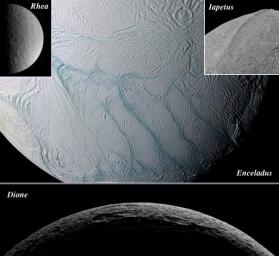
|
Season of Moons
- Click the image above for a larger view
- Full-Res JPEG (1899 x 1740) (405.2 kB)
- Full-Res TIFF (1899 x 1740) (9.9 MB)
Caption:
This montage shows four major icy moons of Saturn that the Cassini spacecraft visited while surveying the Saturnian system during 2005. Even though all of these bodies are made largely of ice, they exhibit remarkably different geological histories and varied surface features.
Craters from meteorite impacts are common features on all of these moons. But since the major moons of Saturn are thought to have all formed at approximately the same time, the different distribution of sizes, shapes and numbers of craters on each of their surfaces tell scientists a great deal about the differences in their geologic histories.
Rhea and Iapetus are thoroughly peppered by impacts, suggesting their surfaces have been exposed to the shooting gallery of space for eons. Dione appears to have regions of terrain that are smoother, with fewer craters, suggesting a slightly younger surface. Dione also has a large system of bright, braided fractures that suggest tectonic activity took place there some time after the moon first formed.
Enceladus, however, possesses a region of terrain near its south pole (shown here), that is so dramatically devoid of impact sites that scientists suspected it was geologically active in the recent past, and perhaps even today. The discovery this year of material jetting from the pole and creating a great plume of icy particles confirmed these suspicions. See PIA07758 for images of the Enceladus plume.
The processes that power the activity on Enceladus remain elusive, as do those that produced the pronounced equatorial bulge on Iapetus. This feature was imaged for the first time by Cassini during a flyby of Iapetus that began New Year's Day. The bulge on Iapetus reaches 20 kilometers (12 miles) above the surrounding terrain in places, making it one of the tallest features in the solar system.
Like many scientific journeys, Cassini's historic survey of Saturn's moons has raised more questions. For example, why small Enceladus (505 kilometers, or 314 miles across) is presently geologically active while much larger Rhea (1,528 kilometers, or 949 miles across) is not. Fortunately, such puzzles are the most exciting sort for scientists interested in uncovering the secrets of Saturn's realm.
Background Info:
The Cassini-Huygens mission is a cooperative project of NASA, the European Space Agency and the Italian Space Agency. The Jet Propulsion Laboratory, a division of the California Institute of Technology in Pasadena, manages the mission for NASA's Science Mission Directorate, Washington, D.C. The Cassini orbiter and its two onboard cameras were designed, developed and assembled at JPL. The imaging operations center is based at the Space Science Institute in Boulder, Colo.
For more information about the Cassini-Huygens mission visit http://saturn.jpl.nasa.gov . The Cassini imaging team homepage is at http://ciclops.org .
Cataloging Keywords:
| Name | Value | Additional Values |
|---|---|---|
| Target | Saturn | Dione, Enceladus, Iapetus, Rhea |
| System | Saturn | |
| Target Type | Planet | Satellite |
| Mission | Cassini-Huygens | |
| Instrument Host | Cassini Orbiter | |
| Host Type | Orbiter | |
| Instrument | Imaging Science Subsystem (ISS) | |
| Detector | ||
| Extra Keywords | Color, Crater, Impact, Plume | |
| Acquisition Date | ||
| Release Date | 2005-12-06 | |
| Date in Caption | ||
| Image Credit | NASA/JPL/Space Science Institute | |
| Source | photojournal.jpl.nasa.gov/catalog/PIA07767 | |
| Identifier | PIA07767 | |
